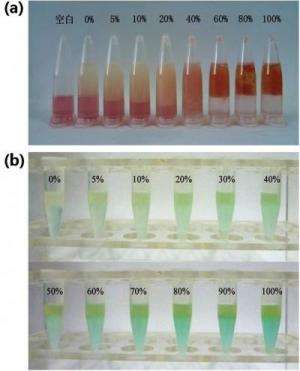Rapid colorimetric detection technology enables illegal cooking oils with no place to hide

In recent years, illegal cooking oil incident led to the serious food safety risks and the negative social repercussions. Professor HE Yujian and his group from College of Chemistry and Chemical Engineering, University of Chinese Academy of Sciences establish two rapid and convenient colorimetric detections of illegal cooking oils based on phase transfer technology. This work could be helpful for the rapid and on-site detection of illegal cooking oil. Their work, entitled "Rapid colorimetric detection of illegal cooking oils based on phase transfer technology", will be published on SCIENCE CHINA Chemistry, 2013(7).
The illegal cooking oil includes the refining of the waste oil from restaurant, the repeatedly used oil and the waste animal fats. Because illegal cooking oil may contain toxic polymer, peroxide and so on, is dangerous to human health. The most common clinical symptoms of poisoning include headache, vomiting and diarrhea abdominal pain. Recently years, because the illegal cooking oil inflows into the family kitchens, it led to the serious food safety risks in China. The administration from the government such as monitoring the purchase records and granting the administrative license can be used to control the problem of illegal cooking oil; however the rapid and on-site detection of illegal cooking oil is still necessary and urgent.
Professor HE Yujian, associate professor ZHAO Hong, doctoral students YUAN Longfei and ZHOU Ying et al., from University of Chinese Academy of Sciences establish two rapid and convenient colorimetric detections of illegal cooking oils based on phase transfer technology. The copper ions and the cationic gold nanoparticles protected by poly (diallyl dimethylammonium) chloride (PDDA) were used as the recognition probes. And the illegal cooking oil could be detected by naked-eye (as shown in the Figure 1). The results showed that qualified cooking oil mixed with 2.8% of the illegal cooking oil could be detected, and more than 5% of the illegal cooking oil could be accurately detected by naked-eye. These methods were applied in blind test for total of 235 samples; the results showed that the accurate rates of the blind tests were 95.7%.
Compared with the traditional methods, this method is a cost-effective process, and allowed rapid and simple colorimetric detection of illegal cooking oils without omplex pre-treatment. The work could provide beneficial methods for the rapid on-site detection of illegal cooking oil. It has a favorable application potential in civilian fields because of its high accuracy, simple and low cost. These research findings have applied for national patent.
More information: SCIENCE CHINA Chemistry, 2013?7?, doi: 10.1360/032012-459













